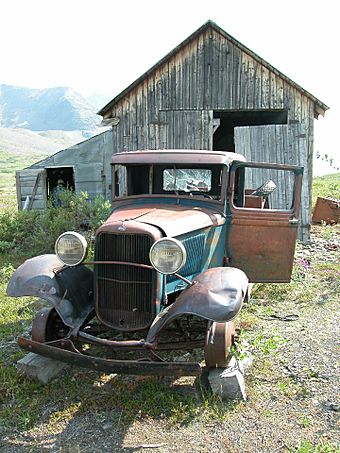Bremner Historic Mining District facts for kids
Quick facts for kids |
|
|
Bremner Historic Mining District
|
|
 |
|
| Location | Along Golconda Creek, about 47 miles (76 km) southeast of Chitina |
|---|---|
| Nearest city | Chitina, Alaska |
| Area | 13,694 acres (5,542 ha) |
| Built | 1934 |
| Architect | Asa C. Baldwin |
| MPS | Mineral Development in Wrangell-St. Elias National Park and Preserve, Alaska MPS |
| NRHP reference No. | 00000659 |
| Added to NRHP | June 15, 2000 |
The Bremner Historic Mining District is a special area in Wrangell–St. Elias National Park and Preserve in Alaska. It is named after John Bremner. He was the first non-native person to live there in 1884-1885. John Bremner was looking for gold along the Bremner River.
This district became famous for a big gold discovery in 1902. It played a huge part in the history of the Copper River area. Only a few miners became rich. But the need for supplies helped create new transportation routes. It also encouraged other businesses and helped settle the entire region.
Contents
Discovering Gold in Bremner
Small-scale placer mining continued for over 40 years. Placer mining involves finding gold in riverbeds. But most of the larger "lode" mining happened between 1934 and 1941. Lode mining means digging for gold in veins within rocks. This was the most important time for the district.
The Bremner Historic Mining District shows how mining worked in the 1900s. It still has almost all its original parts. These include an important placer mining spot, a camp, four different lode mines, a mill, and old transportation routes.
Early Gold Rush Days
The Golconda Mining Company site is a great example of early placer mining. It has an old campsite and a detailed ditch system. There are also large piles of rocks stacked by hand. This complex also includes two airstrips from the 1930s. These were used to bring in supplies.
The Yellow Band Camp and Asa Baldwin
The Yellow Band mining camp is one of the most complete camps in the area. It has housing and office buildings. It also features a complex system that used water to create electricity.
This camp is important because of Asa C. Baldwin. He was a famous explorer, surveyor, and mining engineer. Baldwin completed the first American marine survey of Kodiak and the Aleutian Islands in 1909. He also worked on the U.S.-Canadian International Boundary Survey.
Baldwin advised big companies like the Kennecott Copper Company. He started looking for gold in the Bremner District in the early 1930s. From 1936 to 1940, he was the president of the Yellow Band Mining Company. He bought the Bremner Gold Mining Company in 1939.
Important Mines and People
The Lucky Girl, Grand Prize, Sheriff, and Yellow Band Mines were remote underground mining operations. Each mine had various buildings and structures. The Lucky Girl mill was damaged by many avalanche strikes. But its machinery is still there and mostly in its original place.
Besides Baldwin, the Bremner district is linked to aviator Merle "Mudhole" Smith. He started flying supplies for the Cordova Air Service in the 1930s. He even got stuck on the upper Golconda airstrip once. Smith ran Cordova Air Service until 1968. Then it joined with Alaska Airlines.


